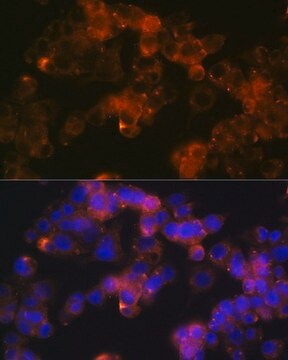S8321
Monoclonal Anti-Sonic Hedgehog (Shh) antibody produced in mouse
clone SH154, purified from hybridoma cell culture
Sinónimos:
Anti-Shh
About This Item
Productos recomendados
biological source
mouse
Quality Level
conjugate
unconjugated
antibody form
purified immunoglobulin
antibody product type
primary antibodies
clone
SH154, monoclonal
form
buffered aqueous solution
species reactivity
human, rat, mouse
concentration
~2 mg/mL
technique(s)
immunohistochemistry: 1:500 using formaldehyde-fixed human tissue sections
indirect ELISA: 2 μg/mL
western blot: 2 μg/mL using recombinant mouse SHH peptide
isotype
IgG1
UniProt accession no.
shipped in
dry ice
storage temp.
−20°C
target post-translational modification
unmodified
Gene Information
human ... SHH(6469)
mouse ... Shh(20423)
rat ... Shh(29499)
General description
Anti-Sonic Hedgehog antibody recognizes human, rat and mouse Shh.
Specificity
Application
Biochem/physiol Actions
Physical form
Disclaimer
¿No encuentra el producto adecuado?
Pruebe nuestro Herramienta de selección de productos.
related product
Storage Class
10 - Combustible liquids
wgk_germany
WGK 3
flash_point_f
Not applicable
flash_point_c
Not applicable
ppe
Eyeshields, Gloves, multi-purpose combination respirator cartridge (US)
Elija entre una de las versiones más recientes:
¿Ya tiene este producto?
Encuentre la documentación para los productos que ha comprado recientemente en la Biblioteca de documentos.
Artículos
Cancer stem cell media, spheroid plates and cancer stem cell markers to culture and characterize CSC populations.
Nuestro equipo de científicos tiene experiencia en todas las áreas de investigación: Ciencias de la vida, Ciencia de los materiales, Síntesis química, Cromatografía, Analítica y muchas otras.
Póngase en contacto con el Servicio técnico






